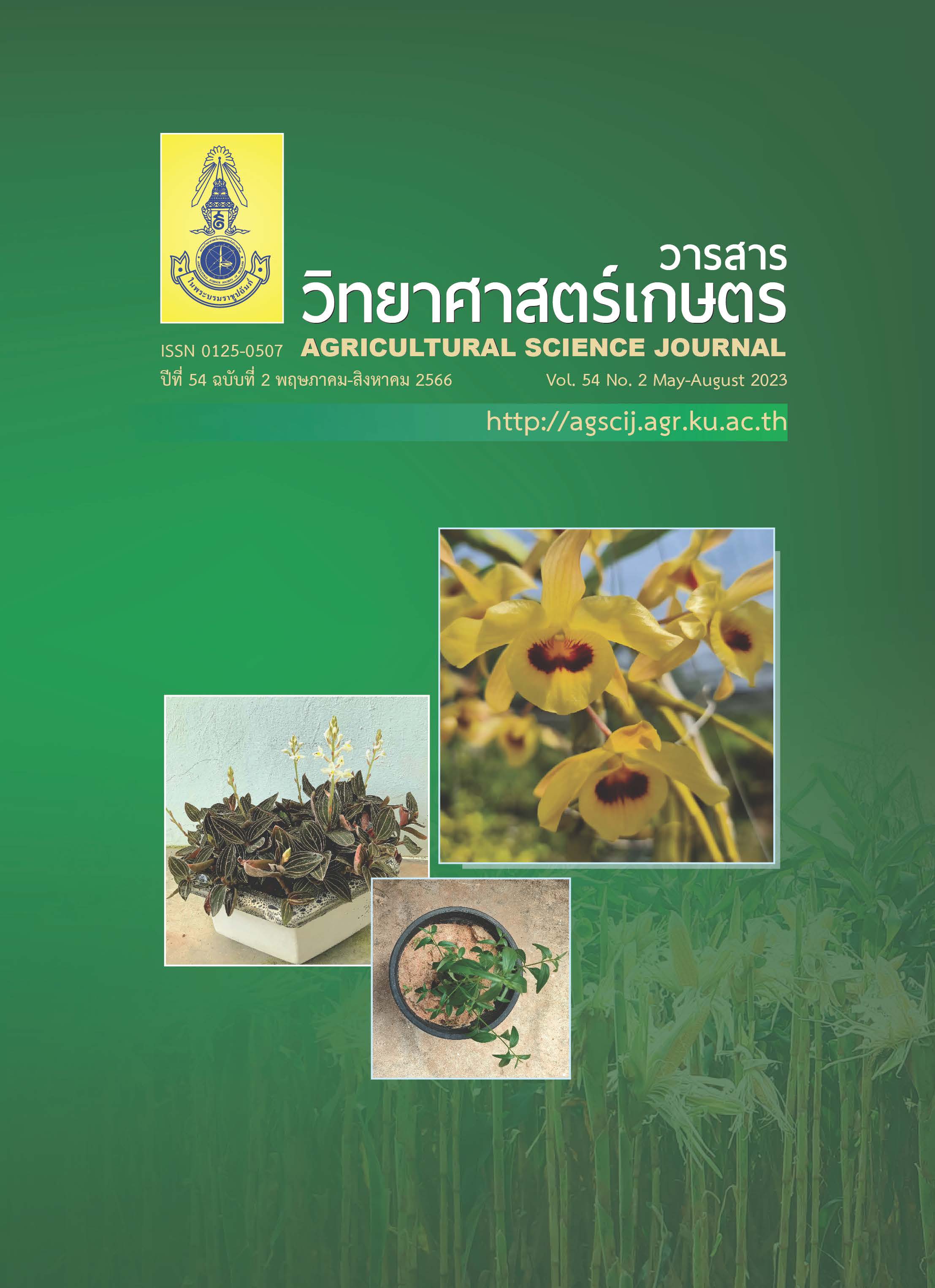การเปรียบเทียบการเจริญเติบโตและเภสัชกรรมสมุนไพรทางการเกษตรของกล้วยไม้หวายเหลืองจันทบูร(Dendrobium friedericksianum Rchb. F.) ที่ปลูกต่างพื้นที่
Main Article Content
บทคัดย่อ
ความเป็นมาและวัตถุประสงค์: ข้อมูลการเจริญเติบโตและปริมาณสารที่เป็นประโยชน์ทางเภสัชกรรมสมุนไพรของกล้วยไม้หวายเหลืองจันทบูร (Dendrobium friedericksianum Rchb. F.) ที่รวบรวมได้ในเขตจังหวัดจันทบุรีและตราดถูกนำมาศึกษาเชิงเปรียบเทียบเพื่อเพิ่มโอกาสในการผลิตเป็นสมุนไพรทางการค้า
วิธีดำเนินการวิจัย: กล้วยไม้ที่รวบรวมได้ถูกจัดเป็น 5 กลุ่มพันธุ์ ได้แก่ กลุ่มจันทบุรี-มีตาดำ จันทบุรี-ไม่มีตาดำ ตราด-มีตาดำ ตราด-ไม่มีตาดำ และจันทบุรี-สวนเกษตรกร รวม 80 ต้น แล้วนำไปปลูกทดสอบที่พื้นที่ของศูนย์วิจัยเกษตรหลวงเชียงใหม่ ศูนย์วิจัยพืชสวนยะลา ศูนย์วิจัยพืชสวนจันทบุรี และสวนเกษตรกรจังหวัดปทุมธานี (พื้นที่ละ 20 ตัวอย่าง) เมื่ออายุ 20 เดือน ข้อมูลถูกรวบรวมและนำมาวิเคราะห์ทางสถิติ
ผลการวิจัย: กล้วยไม้หวายเหลืองจันทบูรมีการเจริญเติบโตเฉลี่ย 4.69 ± 1.87 ลำ ซึ่งผันแปรไปตามอิทธิพลร่วมระหว่างกลุ่มพันธุ์และสถานที่ปลูกตัวอย่าง (P < 0.001) เมื่อเริ่มต้น กล้วยไม้หวายเหลืองจันทบูรมีปริมาณ eriodictyol เฉลี่ย 0.0144 ± 0.0040 % w/w มีปริมาณ homoeriodictyol เฉลี่ย 0.0157 ± 0.0032 % w/w และมีปริมาณ chrysotoxine เฉลี่ย 0.0720 ± 0.0223 % w/w การเปลี่ยนแปลงของ eriodictyol ที่พบในกล้วยไม้สกุลหวายเหลืองจันทบูรต่างกลุ่มพันธุ์และที่ปลูกต่างพื้นที่แตกต่างกันอย่างไม่มีนัยสำคัญทางสถิติ การเปลี่ยนแปลงของปริมาณ homoeriodictyol ผันแปรไปตามพื้นที่ปลูก (P < 0.05) เท่านั้น ส่วนการเปลี่ยนแปลงของปริมาณ chrysotoxine ผันแปรไปตามกลุ่มพันธุ์ (P < 0.05) และพื้นที่ปลูก (P < 0.05) ในภาพรวมของทุกพื้นที่ปลูกทดสอบกล้วยไม้หวายเหลืองจันทบูรกลุ่มพันธุ์ตราด-ไม่มีตาดำมีระดับการผลิต chrysotoxine สูงที่สุด
สรุป: ผลการศึกษานี้ชี้ให้เห็นถึงโอกาสในการบริหารจัดการการผลิตต้นกล้วยไม้ที่มีสารสำคัญทางเภสัชกรรมสมุนไพรโดยวิธีการเขตกรรมปลอดภัยเชิงพาณิชย์
Article Details

อนุญาตภายใต้เงื่อนไข Creative Commons Attribution-NonCommercial-NoDerivatives 4.0 International License.
เอกสารอ้างอิง
Arya, S.S., J.E. Rookes, D.M. Cahill and S.K. Lenka. 2021. Vanillin: a review on the therapeutic prospects of a popular flavouring molecule. Adv. Tradit. Med. 21: 415–431. https://doi.org/10.1007/s13596-020-00531-w.
Bhummaphan, N., V. Pongrakhananon, B. Sritularak and P. Chanvorachote. 2018. Cancer stem cell–suppressing activity of chrysotoxine, a bibenzyl from Dendrobium pulchellum. J. Pharmacol. Exp. Ther. 364(2): 332–346. https://doi.org/10.1124/jpet.117.244467.
Choonong, R., W. Sermpradit, T. Kitisripanya, B. Sritularak and W. Patalun. 2019. The contents of bibenzyl derivatives, flavonoids and a phenanthrene in selected Dendrobium spp. and the correlation with their antioxidant activity. Sci. Asia. 45: 245–252. http://doi.org/10.2306/scienceasia1513-1874.2019.45.245.
Deng, Z., S. Hassan, M. Rafig, H. Li, Y. He, Y. Cai, X. Kang, Z. Liu and T. Yan. 2020. Pharmacological activity of eriodictyol: the major natural polyphenolic flavanone. Evid. Based Complement. Alternat. Med. 2020: 6681352. https://doi.org/10.1155/2020/6681352.
Department of Agricultural Extension. 2020. Action Plan of Orchids 2020–2022. Ministry of Agricultural and Cooperatives, Bangkok, Thailand. 12 pp. (in Thai)
Department of National Parks, Wildlife and Plant Conservation. 2017. Threatened Plants in Thailand. Ministry of Natural Resources and Environment, Bangkok, Thailand. 224 pp. (in Thai)
Ghorbanpour, M. and A. Varma. 2017. Medicinal Plants and Environmental Challenges. Springer International Publishing AG, Switzerland. 413 pp.
Guo, P., M. Zeng, S. Wang, B. Cao, M. Liu, Y. Zhang, J. Jia, Q. Zhang, B. Zhang, R. Wang, X. Zheng and W. Feng. 2022. Eriodictyol and homoeriodictyol improve memory impairment in Aß25–35-induced mice by inhibiting the NLRP3 inflammasome. Molecules. 27(8): 2488. https://doi.org/10.3390%2Fmolecules27082488.
Jan, R., S. Asaf, M. Numan, Lubna and K.M. Kim. 2021. Plant secondary metabolite biosynthesis and transcriptional regulation in response to biotic and abiotic stress conditions. Agronomy. 11(5): 968. https://doi.org/10.3390/agronomy11050968.
Kasinkasaempong, Y. 2017. Development of Dendrobium orchids for medicinal uses, pp. 147–153. In Orchid Production Technology. Horticultural Research Institute, Department of Agriculture, Ministry of Agriculture and Cooperatives, Bangkok, Thailand. (in Thai)
Klongkummnuankarn, P., B. Sritularak and K. Likhitwitayawuid. 2014. Cytotoxic constituents against KB cells from Dendrobium brymerianum, pp. 1533–1539. In Proc. the 15th Graduate Research Conferences, 28 March 2014.
Li, Y., D. Kong, Y. Fu, M.R. Sussman and H. Wu. 2020. The effect of developmental and environmental factors on secondary metabolites in medicinal plants. Plant Physiol. Biochem. 148: 80–89. https://doi.org/10.1016/j.plaphy.2020.01.006.
Liu, Q., L. Liu, J. Zhou, H.D. Shin, R.R. Chen, C. Madzak, J. Li, G. Du and J. Chen. 2013. Biosynthesis of homoeriodictyol from eriodictyol by flavone 3’–O–methyltransferase from recombinant Yarrowia liophytica: heterologous expression, biochemical characterization, and optimal transformation. J. Biotechnol. 167(4): 472–478. https://doi.org/10.1016/j.jbiotec.2013.07.025.
Singh, D.R., R. Kishore, R. Kumar and A. Singh. 2016. Orchid Preparation. Astral International (P) Ltd., New Delhi, India. 66 pp.
Sritularak, B. 2021. Dendrobium Orchids: Potential for Medicinal Uses. Chulalongkorn University Printing House, Bangkok, Thailand. 200 pp. (in Thai)
Thaithong, O. 2016. Thai Orchids. 12th edition. Home and Garden, Amarin Printing and Publishing, Bangkok, Thailand. 461 pp. (in Thai)
Unahabhokha, T., P. Chanvorachote, B. Sritularak, J. Kitsongsermthon and V. Pongrakhananon. 2016. Gigantol inhibits epithelial to mesenchymal process in human lung cancer cells. Evid. Based Complement. Alternat. Med. 2016: 4561674. https://doi.org/10.1155/2016/4561674.
Zhu, S., J. Wu, G. Du, J. Zhou and J. Chen. 2014. Efficient synthesis of eriodictyol from L-tyrosine in Escherichia coli. Appl. Environ. Microbiol. 80(10): 3072–3080. https://doi.org/10.1128/aem.03986-13.


